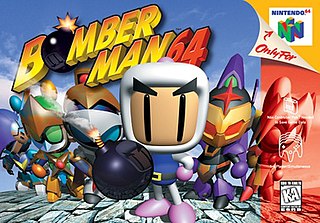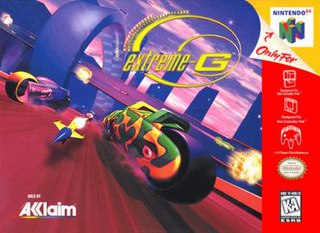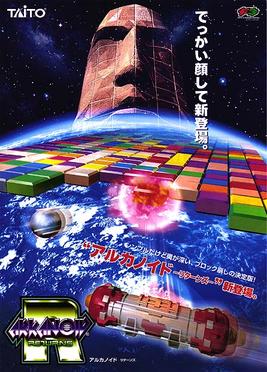
Tetris Attack, also known as Panel de Pon in Japan, is a puzzle video game developed by Intelligent Systems and published by Nintendo for the Super Nintendo Entertainment System. A Game Boy version was released a year later. In the game, the player must arrange matching colored blocks in vertical or horizontal rows to clear them. The blocks steadily rise towards the top of the playfield, with new blocks being added at the bottom. Several gameplay modes are present, including a time attack and multiplayer mode.

Arkanoid is a 1986 block breaker arcade game developed and published by Taito. In North America, it was published by Romstar. Controlling a paddle-like craft known as the Vaus, the player is tasked with clearing a formation of colorful blocks by deflecting a ball towards it without letting the ball leave the bottom edge of the playfield. Some blocks contain power-ups that have various effects, such as increasing the length of the Vaus, creating several additional balls, or equipping the Vaus with cannons. Other blocks may be indestructible or require multiple hits to break.

Super Metroid is a 1994 action-adventure game developed by Nintendo and Intelligent Systems and published by Nintendo for the Super Nintendo Entertainment System. It is the third installment in the Metroid series, following the events of the Game Boy game Metroid II: Return of Samus (1991). Players control bounty hunter Samus Aran, who travels to planet Zebes to retrieve an infant Metroid creature stolen by the Space Pirate leader Ridley.

Star Fox 64, known as Lylat Wars in the PAL regions, is a 1997 3D rail shooter video game developed and published by Nintendo for the Nintendo 64. It is the second installment in the Star Fox series and a reboot of the original Star Fox for the Super Nintendo Entertainment System.

Diddy Kong Racing is a 1997 racing video game developed and published by Rare for the Nintendo 64. The game is set on Timber's Island and revolves around Diddy Kong and his friends' attempt to defeat the intergalactic antagonist, a wizarding pig named Wizpig, through winning a series of races. The player can take control of any of the featured characters throughout the game. Diddy Kong Racing features five worlds with four racetracks each, and the ability to drive a car, hovercraft, or pilot an aeroplane. Timber Island is loosely based on the geographical landscapes of the United States.

Kirby Super Star, released as Kirby's Fun Pak in PAL regions, is an anthology platform video game developed by HAL Laboratory and published by Nintendo for the Super Nintendo Entertainment System in 1996. It is part of the Kirby series of video games by HAL Laboratory. The game was advertised as a compilation featuring eight games: seven short subsections with the same basic gameplay, and two minigames.

Bomberman 64 is a video game developed by Hudson Soft, published by Hudson Soft in Japan, and published by Nintendo in North America and Europe for the Nintendo 64. The game was released in Europe and North America in November and December 1997, respectively. While the game never saw a release on the Wii's Virtual Console service, it was eventually released on the Wii U Virtual Console in both Europe and North America in March 2017 followed by Japan in June 2017.

Ninja Gaiden II: The Dark Sword of Chaos, known in Europe as Shadow Warriors II: The Dark Sword of Chaos, is a side-scrolling platform game developed and published by Tecmo for the Nintendo Entertainment System (NES). This is the second installment in the Ninja Gaiden trilogy for the NES and was released in North America and Japan in 1990, and in Europe in 1992. An arcade video game version was also introduced by Nintendo for their PlayChoice-10 system in 1990.

Metal Combat: Falcon's Revenge is a 1993 light gun shooter video game developed by Intelligent Systems and published by Nintendo for the Super Nintendo Entertainment System. It is the sequel to Battle Clash (1992) and one of several titles that require the Super Scope light gun. Taking place three years after the events of its predecessor, the player acts as the gunner of the Standing Tank (ST) Falcon piloted by Mike Anderson, fighting a group of chiefs in the Battle Game, the returning emperor Anubis, and the invading Eltorian alien race.

The Super NES Mouse, sold as the Super Famicom Mouse in Japan, is a peripheral created by Nintendo for the Super Nintendo Entertainment System. It was released in 1992, on July 14 in Japan, in August in North America, and on December 10 in Europe. Originally designed for use with the game Mario Paint, the Super NES Mouse was sold in a bundle with the game and included a plastic mouse pad. Soon after its introduction, several other titles were released with Mouse support.

Bomberman Generation is a 2002 video game released for the GameCube. It was followed up by Bomberman Jetters.

Mega Man X3, known as Rockman X3 (ロックマンX3) in Japan, is a video game released by Capcom for the Super Nintendo Entertainment System (SNES). The game was originally released in Japan on December 1, 1995, and later in North American and PAL regions in 1996. It is the third game in the Mega Man X series and the last to appear on the SNES. Mega Man X3 takes place in a fictional future in which the world is populated by humans and intelligent robots called "Reploids". Like their human creators, some Reploids involve themselves in destructive crime and are labelled as "Mavericks". After twice defeating the Maverick leader Sigma, the heroes X and Zero must battle a Reploid scientist named Dr. Doppler and his utopia of Maverick followers.

Mega Man: Dr. Wily's Revenge, also known as Mega Man in Dr. Wily's Revenge or in Japan as Rockman World is an action-platform video game by Capcom for the Nintendo Game Boy. It is the first game in the handheld series of the Mega Man franchise. It was released in Japan on July 26, 1991, and was localized in North America that December and in Europe the following year. The game continues the adventures of the android hero Mega Man as he once again confronts the evil Dr. Wily, who has dispatched his revived "Robot Masters" and a new "Mega Man Killer" named Enker.

Kirby’s Block Ball, known in Japan as Kirby no Block Ball, is a 1995 video game developed by Tose and Nintendo and published by Nintendo for the Game Boy portable console. It is a spin-off of the Kirby video game series. It is a Breakout clone; the player controls paddles along the screen's edge to knock a bouncing ball, Kirby, into destructible bricks. The game's 55 levels include power-ups, bonus rounds, and minigames. The team spent half a year revising the gameplay to match Kirby's signature characteristics. Kirby's Block Ball was released in Japan on December 14, 1995, later in North America on May 13, 1996 and finally in Europe on August 29, 1996.

Extreme-G is a futuristic racing video game developed by Probe Entertainment and published by Acclaim Entertainment, featuring an original trance soundtrack. It was released for the Nintendo 64 in 1997, and was released in Japan on May 29, 1998. Despite the crowded field of Nintendo 64 racing games, Extreme-G was met with moderately positive reviews and was a commercial success. A sequel, Extreme-G 2, was released in 1998, followed by two additional games: Extreme-G 3 (2001) and XGRA: Extreme G Racing Association (2003). In 2024, the game was re-released through the Nintendo Switch Online + Expansion Pack through Throwback Entertainment, who purchased the rights to the game in 2006.

Arkanoid: Revenge of Doh is an arcade game released by Taito in 1987 as a sequel to Arkanoid.

Arkanoid Returns is an arcade game released by Taito in February 1997 as part of the Arkanoid series. It is the fourth overall, and third to be released in arcades. The game was ported to the PlayStation later the same year, with an updated home release being released afterwards titled Arkanoid R 2000.

Bomberman '93 is a video game in the Bomberman series. It was released on the PC Engine on December 11, 1992 in Japan, with western TurboGrafx-16 releases following in 1993. The game was also re-released for PCs in 2002 alongside the TurboGrafx-16 version of Bomberman and Bomberman World as part of a compilation disc titled Bomberman Collection. The game was re-released for the Virtual Console, with full multiplayer capability intact, for Wii on November 21, 2006 in North America, December 8, 2006 in Europe, and July 6, 2007 in Australia. The game was re-released for the Wii U on December 28, 2016 in Japan, November 30, 2017 in North America and December 14, 2017 in Europe. Bomberman '93 later spawned a sequel titled Bomberman '94.

Metroid is an action-adventure game developed and published by Nintendo. The first installment in the Metroid series, it was originally released in Japan for the Family Computer Disk System in August 1986. North America received a release in August 1987 on the Nintendo Entertainment System in the Game Pak ROM cartridge format, with the European release following in January 1988. Set on the planet Zebes, the story follows Samus Aran as she attempts to retrieve the parasitic Metroid organisms that were stolen by Space Pirates, who plan to replicate the Metroids by exposing them to beta rays and then use them as biological weapons to destroy Samus and all who oppose them.

Fun 'n Games is a compilation video game developed by Leland Interactive Media and released for the Super NES and Mega Drive/Genesis platforms in 1993 and 1994. In 1995, an updated, redeveloped version of the game was released on the 3DO Interactive Multiplayer and MS-DOS by Williams Entertainment Inc. The North American Super NES version of the game is considered to be one of the more rare games released for the console.





















